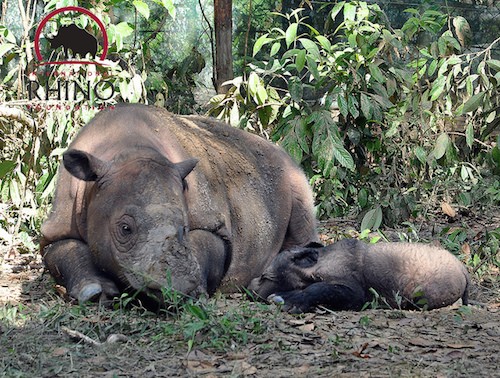Courtesy of International Rhino Foundation

FORT WORTH, Texas — A new rhino calf will soon join five other rhinos at the Sumatran Rhino Sanctuary in Indonesia’s Way Kambas National Park, offering new hope for the endangered species.
Female rhino ‘Ratu,’ who wandered out of the rainforest in 2005, will give birth in May. Her first calf, ‘Andatu,’ was born at the facility in 2012. Andatu, as well as the new calf-to-be, was fathered by ‘Andalas,’ born at the Cincinnati Zoo and moved to Indonesia from the Los Angeles Zoo in 2007.
Today’s announcement gives special significance to World Rhino Day, which is intended to increase awareness and support for the five remaining species of rhinos. Increasingly, all rhino species are facing serious threats from poaching to habitat loss and conservation experts are working against the clock to save them.
“The Sumatran Rhino Sanctuary made history in 2012 with the birth of Andatu, the first Sumatran rhino born in an Asian breeding facility in more than 140 years,” said Dr. Siti Urbana Bakar, the Indonesian Minister of Environment and Forestry under whose aegis the Sanctuary operates.
“The pregnancy represents nearly two decades of international collaboration to save the species.”
Sumatran rhino pregnancies last roughly 16 months, and babies generally weigh between 50 and 60 pounds. Reproductive specialists confirm that ultrasound images of the developing calf indicate that the pregnancy is progressing normally. Only four Sumatran rhinos have been born at breeding facilities, including the Sumatran Rhino Sanctuary and the Cincinnati Zoo.

The Sanctuary was built in 1996 by the International Rhino Foundation (IRF) and is operated in partnership with the Rhino Foundation of Indonesia and the Ministry. The last Sumatran rhino in the United States, Andalas’ brother ‘Harapan,’ will be moved from the Cincinnati Zoo to the Sanctuary later this year.
“One birth doesn’t save a species, but it’s one more Sumatran rhino on Earth,” said Dr. Susie Ellis, executive director of the International Rhino Foundation.
“The new calf affirms that there is expertise in Indonesia to breed Sumatran rhinos. This pregnancy comes at a critical time for the species, which now numbers no more than 100 individuals in the wild.”
In partnership with the Rhino Foundation of Indonesia, IRF helps to manage 13 Rhino Protection Units in two of the three national parks in which the Sumatran rhino is found. Two other rhino species, the white rhino and the greater one-horned rhino, have been brought back from the brink of extinction to stable numbers today.
“With the recent extinction of the Sumatran rhino in Malaysia, the responsibility for saving this species rests squarely with Indonesia,” said Ellis. “In light of the threats from poaching and habitat destruction, the government of Indonesia needs to secure the future of the remaining populations and habitats of Sumatran rhinos. The International Rhino Foundation and other partners will stand shoulder-to-shoulder with the Indonesian government to build the necessary collaboration between government agencies and conservation groups, as well as to strengthen public support.”
Building on lessons learned in Africa, India and Nepal, rhino experts convened a series of strategic conservation planning meetings this spring, supported by the Disney Conservation Fund. Key recommendations included increasing protection of core populations by establishing and enforcing Intensive Protection Zones, enhancing the effectiveness of park management; and intensive management of small populations for rhinos, including moving isolated animals with reproductive potential to the Sumatran Rhino Sanctuary. With the expertise in breeding and veterinary care now in place in Indonesia, the facility could, with expansion, augment wild populations.
For more information, visit the International Rhino Foundation at www.rhinos.org. To learn more about IRF’s Team Rhino campaign, visit www.TeamRhino.org.




